
Grand Temporary Performance Venue Built for 1908 Saengerfest
(Written by Scott Brouwer, Archives Staff)
With no auditorium, or even a music hall capable of housing more than a few hundred people, La Crosse was awarded the honor of hosting the 1908 Saengerfest, a biennial music festival attended by thousands of singers and music lovers from all parts of the United States.
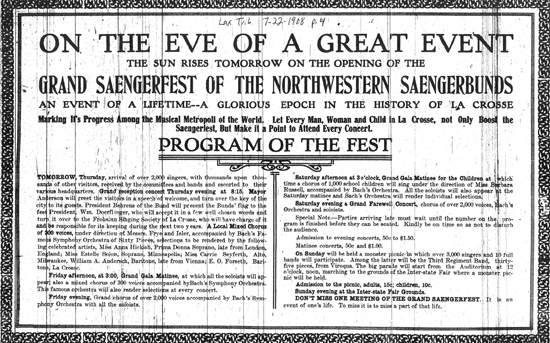
La Crosse Tribune 22 July 1908
Though seemingly unprepared for the 1908 festival, this was not the first time La Crosse would host the Saengerfest event. An early version of what it would become was hosted here in July of 1866, with signing societies from Watertown, Portage, Bangor, Waumadee, Lansing (IA), and Brownsville (MN), among others, joining the La Crosse Turnverein and Leiderkranz signing societies. A parade of the groups preceded a long afternoon program, followed by a grand outdoor ball along the Mississippi River illuminated by 500 lamps.
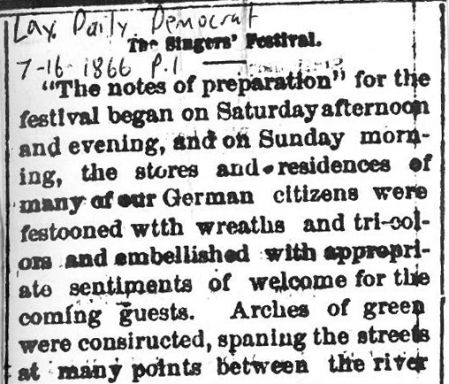
La Crosse Daily Democrat 16 July 1866
The 1894 Saengerfest hosted here was a much grander event. Staged at the Empire Rink, a large indoor roller skating venue at 10th and Cameron, the opening concert was reported to have drawn over 3,000 attendees and featured a joint choir of 700 singers. The event was paired with a Schützenfest, featuring target shooting competitions that drew participants from all over the upper Midwest.
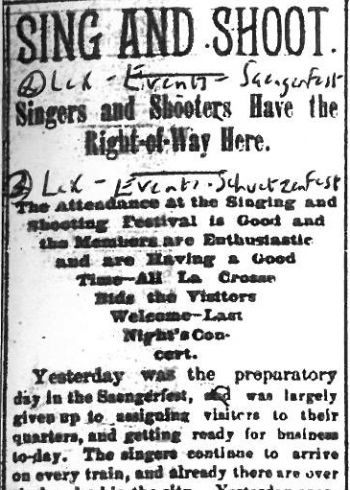
La Crosse Republic & Leader 13 July 1894
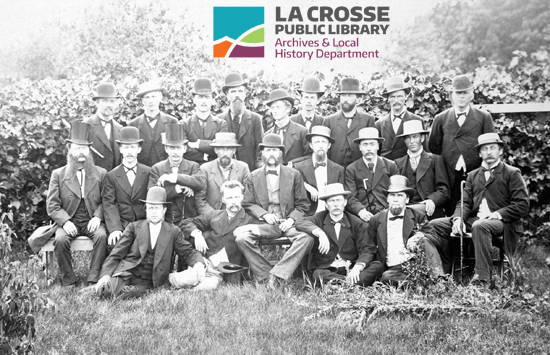
Normanna Sangerkor singing society, 1879
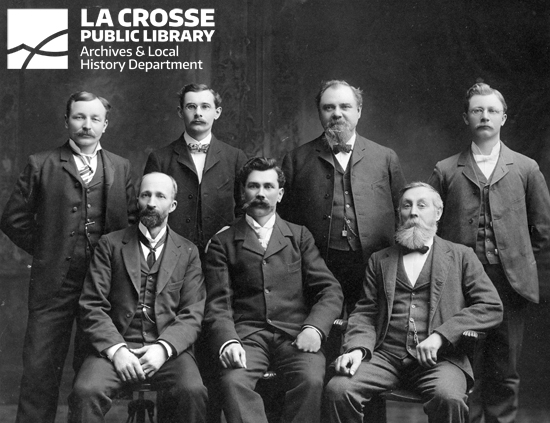
Frohsinn Singing Society, ca. 1900
1866 and 1894 laid the groundwork for planning the 1908 event. According to the newspaper reports at the time, the La Crosse representative at Saengerfest planning meetings overestimated La Crosse’s infrastructure to successfully host an event that would draw thousands of singers and attendees. Hotels hurriedly made plans for doubling the capacities, public halls and ballrooms were converted into dormitories, and private homes prepared their vacant rooms for renters. The biggest hurdle to overcome, though, was the lack of a performance venue big enough to handle the Saengerfest programs and concerts, many which featured joint choirs numbering in the hundreds.
Not until 1955, when the Mary E. Sawyer Auditorium was completed, would La Crosse have a permanent event space dedicated to hosting large events and conferences. An initial idea for the 1908 Saengerfest was to hastily build a civic building that serve as both a public auditorium and home for the local National Guard companies. When it was determined that state funds would be unavailable for this without calling for a special session of the state legislature, this idea was quickly scrapped. Consensus quickly coalesced around turning the long-vacant Second Ward School at the SW corner of 4th and King Streets into an armory and performance venue. While sufficient funds were scraped together from the business community, it was ultimately determined that the building was too ramshackle to safely convert.
With time running out to come up with a solution, a temporary auditorium was conceived. The business community was again tapped for additional funds to make it happen. Hundreds of carpenters began erecting a building on Market Square.

Ca. 1960 aerial of downtown La Crosse, highlighting the former site of Market Square, which occupied the western half of the block bordered by (clockwise from foreground) 4th Street, Jay Street, 5th Avenue, and King Street. The site is now occupied by Market Square city parking ramp and its 4th St. street-level businesses. Cameron Park is the tree-covered area to the right.
A majestic timber performance venue was completed in time for the 1908 Saengerfest. Since it was meant to only be temporary, the planning committee voted not to provide the traditional finishing touches such as stain, paint, or decorative stucco to avoid diminishing the reclamation value of the wood used. To overcome the rawness of the façade, bunting was strung and many national flags flown. The interior design and acoustics, the most important part of a successfully performance venue, were universally praised with a La Crosse Tribune reporter at the time writing “these sterling qualities alone could have brought success to an enterprise hounded with disaster and misfortune.”
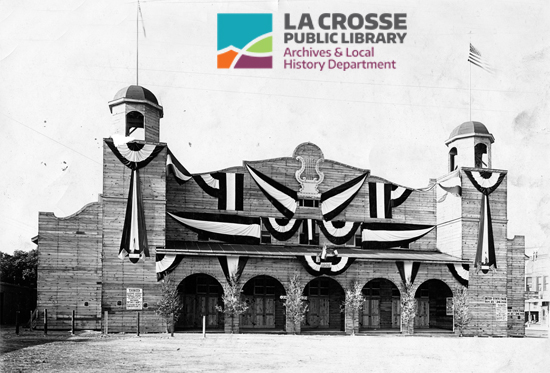

The opening performance for invited singers and spectators alike featured a mass chorus of 3,000 voices composed of choir singers from churches of all denominations for miles around that was reported to have “aroused terrific applause from thousands of delegates from all parts of the country.” Later concerts featured the many invited singing societies and soloists from all over the Midwest and Western states.
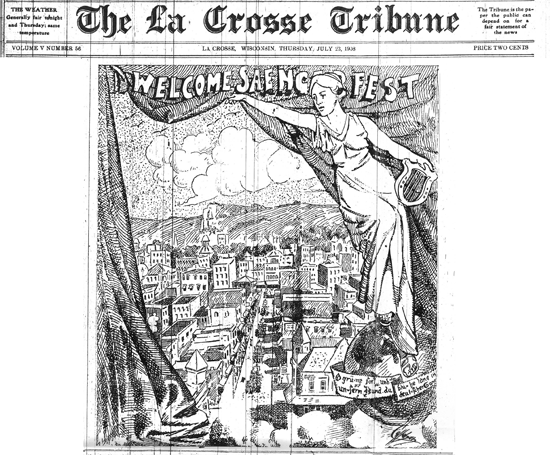

La Crosse Tribune 23 July 1908
For all the initial talk and concern of the event being too big for La Crosse, the 4-day event was reportedly a resounding success. The many railroad lines worked very hard to stay on time for the thousands of daily visitors. When the costs were totaled and the ticket sales counted, the Saengerfest Association planning committee was only slightly in the red. One last sweep of the business community quickly wiped out the outstanding debt, as most felt they had received their money’s worth from the event.
For more information, see:
- La Crosse Saengerfest March, a score composed by Oscar Frey celebrating the 1908 Saengerfest
- La Crosse's German Vereins: Their Rise and Decline, Part 1 blog
- La Crosse's German Vereins: Their Rise and Decline, Part 2 blog
- Normanna Sangerkor blog
- Frohsinn Singing Society blog
- Frohsinn Singing Society collection
- Deutscher Verein collection
